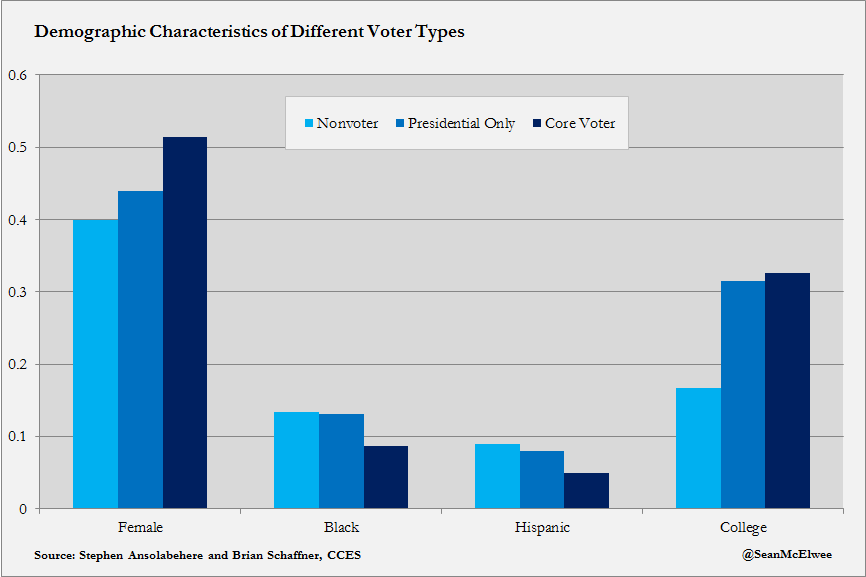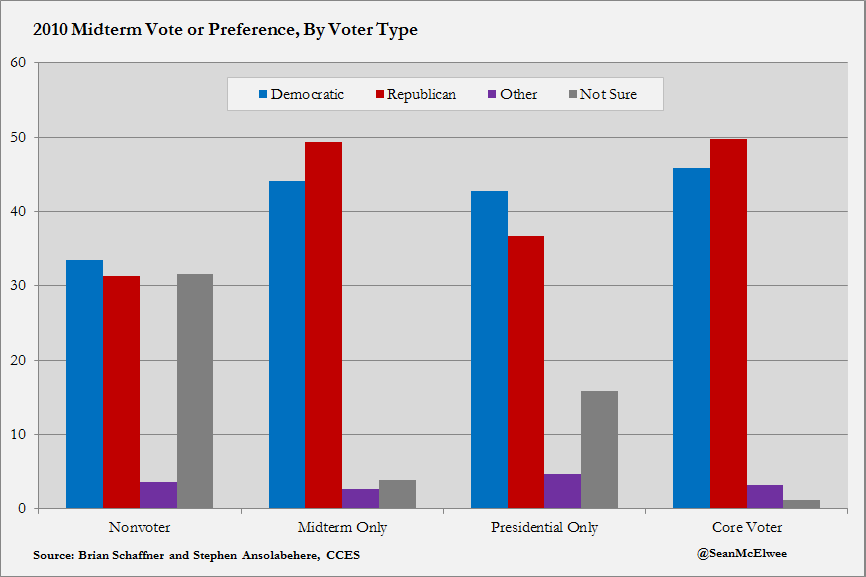This guest post comes from Sean McElwee — a research associate at Demos and an excellent follow on Twitter. Find out more about Sean and his work by checking out his most recent post for Eclectablog. Also be sure to follow Brian Schaffner on Twitter @b_schaffner.
In my latest Salon column, I explore a new working paper by political scientists Stephen Ansolabehere and Brian Schaffner, the most comprehensive examination of voters and nonvoters that has ever been performed. As I note in the piece, studies of non-voters have been difficult because of small samples and because people often misrepresent whether they voted. By validating survey data (comparing what an individual says about voting to their actual voter file) and analyzing a massive database of voter files, the authors are able to give the clearest picture of turnout that has ever been documented. Their findings are rather stunning: they suggest that turnout may well be even more stratified by income, race and gender than previously suspected and that biases in turnout overwhelmingly benefit the Republican party.
Here, I’ll sketch out the biggest lessons from the data.
- A Stunningly Low Share of Americans Vote Regularly
While turnout numbers from the Census Bureau often show voter turnout is high in Presidential elections, it’s an exaggeration to think that 62% of people who voted in 2012 or even the 42% of represent the portion of people who constitute the share of the population who are regular voters. In fact, by examining the voter files of more than 2 million Americans, Schaffner and Ansolabehere find that a mere 25% of Americans voted in all four elections between 2006 and 2012 (they only examined individuals eligible for all four elections). They find that a whopping 37% of Americans voted in none of those elections, and another 11% voted in just one Presidential election. Again: only 25% of Americans can be considered “frequent voters” and given the importance of voting, these results suggest that policy is being dictated by a small, and as we’ll see, unrepresentative group of voters.
- Registration is a Key Barrier to Turnout
As I’ve noted frequently in arguments for automatic voter registration, registration constitutes a core barrier to voting in the United States. First, because large numbers of Americans are unregistered, by default they cannot vote (except in states with same-day registration). But further, being unregistered decreases the chance that parties will target individuals on election day. The new data from Ansolabehere and Schaffner suggest that registration is the most important barrier to turnout: in 2010, 24% of nonvoters cited not being registration as their reason for not voting, in 2012 it was 27% of nonvoters. Large volumes of research suggest that reforms which target registration are the most effective at boosting turnout and reducing biases in the electorate. Thus, robust enforcement of the National Voter Registration Act, expanded access to same day registration and more states adopting automatic voter registration should be key priorities for progressives.
- “Core Voters” Aren’t Demographically Representative
Research suggests that people who vote are richer, whiter, more conservative and older than the general population. Using CCES, Schaffner and Ansolabehere are able to identify how core voters differ from Presidential voters and nonvoters. They find that core voters are whiter, richer and older than the general population. While Blacks make up 13% of nonvoters, they are only 7% of core voters. Hispanics, who are 9% of nonvoters, are only 5% of core voters. The average age of nonvoters is 48, while Presidential voters are younger (the average age 44) and core voters are older (53). Finally, women are overrepresented among core voters (52% of core voters are women, compared to 40% of nonvoters). Previous research by political scientists Ryan Enos, Anthony Fowler and Lynn Vavreck suggests that a one standard deviation increase in propensity to vote correaltes with
- “Core Voters” Are Far More Conservative Than Nonvoters and Presidential Only
The authors show that if only “core voters” had voted in 2012, Obama would have lost the popular vote (48% to 49%). Equally importantly, they show that in the 2010 midterm, nonvoters and Presidential-only voters favored Democrats, while core voters favored Republicans. They estimate that if Presidential-only voters had been added to the electorate, the Republican advantage would have shrunk by three points, leading to “a non-trivial difference in the number of seats won by Republicans.” Numerous data sources confirm that nonvoters and marginal voters (those who turn out infrequently and primarily in Presidential elections) are far more progressive than voters. As I note in my piece, political scientist Anthony Fowler examined how higher turnout might affect elections and discovered that it could lead to as many as 7 House seats each election.
Conclusion:
There are many reasons that progressives struggle to implement policies in the United States. The power of the donor class, the malapportionment of the Senate, the deep status quo bias in policy making, racism and federalism have all hampered progressive change. It’s increasingly clear that low voter turnout and voter turnout that is deeply stratified by race, class, age and education have also made progressive change more difficult. Fighting democratic inequality would help reduce economic inequality.
For more information, read my report Why Voting Matters or the working paper by Brian Schaffner and Stephen Ansolabehere, “Beyond the Core and Periphery: A New Look at Voter Participation Across Elections.”



